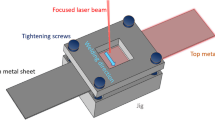Abstract
Reliable electricity transmission in battery cells and modules is indispensable for energy storages. However, common joining technologies for such devices such as bolting or soldering suffer from several drawbacks, including force-dependent resistance or low dynamic strength. Laser beam welding shows potential to overcome these disadvantages. Besides excellent joint properties, it is applicable to small assembly spaces and has potential for the implementation of lightweight construction. In addition, laser beam welding allows users to precisely adjust the weld seam’s electrical conductivity and mechanical strength by an adaption of the weld seam trajectory. For industrial purposes, low costs and short development cycles are crucial. These short development cycles require a fast and easy design-to-production process. Therefore, an adapted Machine Learning method (Generative Adversarial Networks) is presented to simplify and accelerate the weld seam trajectory planning for laser beam welding. The algorithm predicts a suitable weld seam trajectory to achieve the desired electrical conductivity and tensile strength. For the algorithm used, feasibility was demonstrated using a dataset of the Modified National Institute of Standards and Technology (MNIST) database.
Access this chapter
Tax calculation will be finalised at checkout
Purchases are for personal use only
Similar content being viewed by others
References
Liu, X., Ai, W., Naylor Marlow, M., Patel, Y., Wu, B.: The effect of cell-to-cell variations and thermal gradients on the performance and degradation of lithium-ion battery packs. Appl. Energy 248, 489–499 (2019)
Schmidt, P.A., Schweier, M., Zaeh, M.F.: Joining of lithium-ion batteries using laser beam welding: Electrical losses of welded aluminum and copper joints. Int. Congr. Appl. Lasers Electro-Optics, 915–923 (2012)
Schmidt, P.A., Zaeh, M.F.: Laser beam welding of electrical contacts of lithium-ion batteries for electric- and hybrid-electric vehicles. Prod. Eng. Res. Devel. 9(5–6), 593–599 (2015). https://doi.org/10.1007/s11740-015-0637-4
Zwicker, M.F.R., Moghadam, M., Zhang, W., Nielsen, C.V.: Automotive battery pack manufacturing – a review of battery to tab joining. J. Adv. Joining Process. 1, 100017 (2020)
Hollatz, S., Kremer, S., Ünlübayir, C., Sauer, D.U., Olowinsky, A., Gillner, A.: Electrical modelling and investigation of laser beam welded joints for lithium-ion batteries. Batteries 6, 24 (2020)
Goodfellow, I.J., et al.: Generative Adversarial Nets. In: Proceedings of the 27th International Conference on Neural Information Processing Systems – vol. 2. NIPS’14, pp. 2672–2680. MIT Press, Cambridge, MA, USA (2014)
Goodfellow, I., Bengio, Y., Courville, A.: Deep learning. MIT Press, Cambridge, Massachusetts, London, England (2016)
Brownlee, J.: Generative adversarial networks with python: deep learning generative models for image synthesis and image translation. Mach. Learn. Mastery (2019)
Arjovsky, M., Chintala, S., Bottou, L.: Wasserstein GAN. http://arxiv.org/pdf/1701.07875v3. Accessed 27 May 2021
Mirza, M., Osindero, S.: Conditional Generative Adversarial Nets. http://arxiv.org/pdf/1411.1784v1. Accessed 27 May 2021
Borji, A.: Pros and cons of GAN evaluation measures. Comput. Vis. Image Underst. 179, 41–65 (2019)
Heusel, M., Ramsauer, H., Unterthiner, T., Nessler, B., Hochreiter, S.: GANs trained by a two time-scale update rule converge to a local nash equilibrium. In: Guyon, I., et al. (eds.) Advances in Neural Information Processing Systems, vol. 30. Curran Associates, Inc (2017)
Yang, Z., Yu, C.-H., Buehler, M.J.: Deep learning model to predict complex stress and strain fields in hierarchical composites. Sci. Adv. 7 (2021)
Nie, Z., Lin, T., Jiang, H., Kara, L.B.: TopologyGAN: topology optimization using generative adversarial networks based on physical fields over the initial domain. J. Mech. Des. 143, 197 (2021)
Rawat, S., Shen, M.H.: Application of adversarial networks for 3D structural topology optimization. In: SAE Technical Paper Series. SAE Technical Paper Series. SAE International400 Commonwealth Drive, Warrendale, PA, United States (2019)
Lecun, Y., Bottou, L., Bengio, Y., Haffner, P.: Gradient-based learning applied to document recognition. Proc. IEEE 86, 2278–2324 (1998)
Bradski, G.: The OpenCV Library. Dr. Dobb’s J. Softw. Tools 25, 120–125 (2000)
Abadi, M., et al.: TensorFlow: Large-Scale Machine Learning on Heterogeneous Systems. https://www.tensorflow.org. Accessed 27 May 2021
Tieleman, T., Hinton, G.: Lecture 6.5-rmsprop: Divide the gradient by a running average of its recent magnitude. COURSERA: Neural Netw. Mach. Learn. 4(2), 26–31 (2012)
Kingma, D.P., Ba, J.: Adam: A Method for Stochastic Optimization. https://arxiv.org/abs/1412.6980. Accessed 27 May 2021
Acknowledgements
The results presented in this paper were obtained within the research project. ReViSEDBatt – Resonances, Vibrations, Shocks, External Mechanical Forces, and Detection Methods for Lithium-Ion Batteries funded by the Federal Ministry for Economic Affairs and Energy (BMWi). The authors thankfully acknowledge its financial support.
Author information
Authors and Affiliations
Corresponding author
Editor information
Editors and Affiliations
Rights and permissions
Copyright information
© 2022 Springer Nature Switzerland AG
About this paper
Cite this paper
Kick, M.K., Kuermeier, A., Stadter, C., Zaeh, M.F. (2022). Weld Seam Trajectory Planning Using Generative Adversarial Networks. In: Andersen, AL., et al. Towards Sustainable Customization: Bridging Smart Products and Manufacturing Systems. CARV MCPC 2021 2021. Lecture Notes in Mechanical Engineering. Springer, Cham. https://doi.org/10.1007/978-3-030-90700-6_46
Download citation
DOI: https://doi.org/10.1007/978-3-030-90700-6_46
Published:
Publisher Name: Springer, Cham
Print ISBN: 978-3-030-90699-3
Online ISBN: 978-3-030-90700-6
eBook Packages: EngineeringEngineering (R0)




